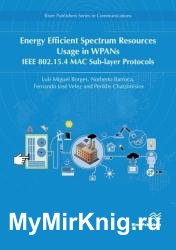 Название: Energy Efficient Spectrum Resources Usage in WPANs: IEEE 82.15.4 MAC Sub-layer Protocols Название: Energy Efficient Spectrum Resources Usage in WPANs: IEEE 82.15.4 MAC Sub-layer Protocols
Автор: Fernando Jose Velez, Luis Miguel Borges
Издательство: River Publishers
Год: 2022
Страниц: 434
Язык: английский
Формат: pdf (true)
Размер: 10.28 MB
Wireless Sensor Networks (WSNs) and the Internet of Things (IoT) are facing tremendous advances both in terms of energy-efficiency as well as in the number of available applications. Consequently, there are open challenges that need to be tackled for the future generation of WSNs, and this book gives answers to some of the important questions that need to be answered. After giving an overview of the WSN protocols and IEEE 802.15.4 standard, this book proposes IEEE 802.15.4 Medium Access Control (MAC) sub-layer performance enhancements by employing not only RTS/CTS combined with packet concatenation but also scheduled channel poling (MC-SCP). Results have shown that the use of the RTS/CTS mechanism improves channel efficiency by decreasing the deferral time before transmitting a data packet. Furthermore, the Sensor Block Acknowledgment MAC (SBACK-MAC) protocol enables more efficiency as it allows the aggregation of several acknowledgement responses in one special Block Acknowledgment (BACK) Response packet.
The throughput and delay performance have been mathematically derived under both ideal conditions (a channel environment with no transmission errors) and non-ideal conditions (with transmission errors). Simulation results successfully validate the proposed analytical models. This research reveals the importance of an appropriate design for the MAC sub-layer protocol for the desired WSN application. Depending on the mission of the WSN application, different protocols are required. Therefore, the overall performance of a WSN application certainly depends on the development and application of suitable e.g., MAC, network layer protocols.
Wireless Sensor Networks (WSNs) are one of the most contemporary breakthrough technological innovations in the field of massive Internet of things (IoT) and machine-type communications of our time. Wireless sensor actuator networks (WSANs) are responsible for interconnecting several wireless sensor nodes by providing global ad-hoc communication and computational capabilities. This type of networks consists of a large number of sensing devices called “sensor nodes” and is capable of linking the Physical (PHY) layer with the digital world by sensing, processing, and transmitting the real-world phenomena, and by converting these signals into a form that can be processed, stored and acted upon.
Since this type of networks are battery operated, energy harvesting can be a solution to make WSNs autonomous while enabling a widespread use of these systems in many applications where the energy storage system can consist of a supercapacitor and/or a rechargeable battery. However, one of the components with the largest power consumption in the sensor nodes is the radio transceiver, as it has a decisive influence in network lifetime.MAC protocols will enable to achieve such energy-efficiency while determining the operation mode of the radio.
Скачать Energy Efficient Spectrum Resources Usage in WPANs: IEEE 82.15.4 MAC Sub-layer Protocols
|